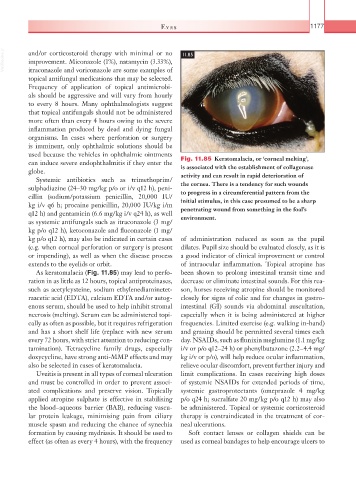Page 1202 - Equine Clinical Medicine, Surgery and Reproduction, 2nd Edition
P. 1202
Eyes 1177
VetBooks.ir and/or corticosteroid therapy with minimal or no 11.85
improvement. Miconazole (1%), natamycin (3.33%),
itraconazole and voriconazole are some examples of
topical antifungal medications that may be selected.
Frequency of application of topical antimicrobi-
als should be aggressive and will vary from hourly
to every 8 hours. Many ophthalmologists suggest
that topical antifungals should not be administered
more often than every 4 hours owing to the severe
inflammation produced by dead and dying fungal
organisms. In cases where perforation or surgery
is imminent, only ophthalmic solutions should be
used because the vehicles in ophthalmic ointments
can induce severe endophthalmitis if they enter the Fig. 11.85 Keratomalacia, or ‘corneal melting’,
globe. is associated with the establishment of collagenase
Systemic antibiotics such as trimethoprim/ activity and can result in rapid deterioration of
sulphadiazine (24–30 mg/kg p/o or i/v q12 h), peni- the cornea. There is a tendency for such wounds
cillin (sodium/potassium penicillin, 20,000 IU/ to progress in a circumferential pattern from the
kg i/v q6 h; procaine penicillin, 20,000 IU/kg i/m initial stimulus, in this case presumed to be a sharp
q12 h) and gentamicin (6.6 mg/kg i/v q24 h), as well penetrating wound from something in the foal’s
as systemic antifungals such as itraconazole (3 mg/ environment.
kg p/o q12 h), ketoconazole and fluconazole (1 mg/
kg p/o q12 h), may also be indicated in certain cases of administration reduced as soon as the pupil
(e.g. when corneal perforation or surgery is present dilates. Pupil size should be evaluated closely, as it is
or impending), as well as when the disease process a good indicator of clinical improvement or control
extends to the eyelids or orbit. of intraocular inflammation. Topical atropine has
As keratomalacia (Fig. 11.85) may lead to perfo- been shown to prolong intestinal transit time and
ration in as little as 12 hours, topical antiproteinases, decrease or eliminate intestinal sounds. For this rea-
such as acetylcysteine, sodium ethylenediaminetet- son, horses receiving atropine should be monitored
raacetic acid (EDTA), calcium EDTA and/or autog- closely for signs of colic and for changes in gastro-
enous serum, should be used to help inhibit stromal intestinal (GI) sounds via abdominal auscultation,
necrosis (melting). Serum can be administered topi- especially when it is being administered at higher
cally as often as possible, but it requires refrigeration frequencies. Limited exercise (e.g. walking in-hand)
and has a short shelf life (replace with new serum and grazing should be permitted several times each
every 72 hours, with strict attention to reducing con- day. NSAIDs, such as flunixin meglumine (1.1 mg/kg
tamination). Tetracycline family drugs, especially i/v or p/o q12–24 h) or phenylbutazone (2.2–4.4 mg/
doxycycline, have strong anti-MMP effects and may kg i/v or p/o), will help reduce ocular inflammation,
also be selected in cases of keratomalacia. relieve ocular discomfort, prevent further injury and
Uveitis is present in all types of corneal ulceration limit complications. In cases receiving high doses
and must be controlled in order to prevent associ- of systemic NSAIDs for extended periods of time,
ated complications and preserve vision. Topically systemic gastroprotectants (omeprazole 4 mg/kg
applied atropine sulphate is effective in stabilising p/o q24 h; sucralfate 20 mg/kg p/o q12 h) may also
the blood–aqueous barrier (BAB), reducing vascu- be administered. Topical or systemic corticosteroid
lar protein leakage, minimising pain from ciliary therapy is contraindicated in the treatment of cor-
muscle spasm and reducing the chance of synechia neal ulcerations.
formation by causing mydriasis. It should be used to Soft contact lenses or collagen shields can be
effect (as often as every 4 hours), with the frequency used as corneal bandages to help encourage ulcers to

